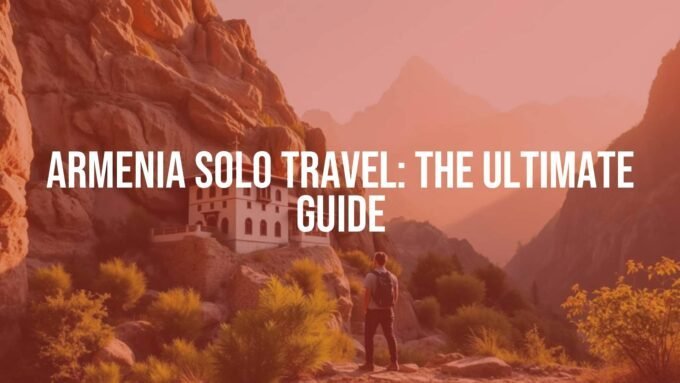Planning a trip to Armenia is exciting. This small country is full of history, dramatic scenery, and strong cultural traditions. Sitting between Asia and Europe, Armenia mixes old and new: Yerevan’s lively streets and pink stone buildings, and quiet cliffside monasteries. Whether you love ancient sites, mountain hikes, or friendly locals, good planning will help you have a memorable and rich trip.
This full guide will take you through each step of planning, from reasons to go, to budget, transport, places to stay, and the best things to see and do. Get ready to discover a country that, while still off most mass-tourism routes, stands out with its rich history, great food, and striking natural beauty.
Why Visit Armenia?
What Makes Armenia Unique?
Called “The Land of Apricots,” Armenia is colorful and deeply historic. It is known as the first Christian nation, a story written into the land with countless old monasteries and churches. From Yerevan’s pink glow to Gyumri’s dark stone and gold trim, the green Debed Canyon, and the deep blue of Lake Sevan, the views are vivid and varied.
Armenian culture is full of detail and meaning. Khachkar cross stones, seen in city parks and along monastery paths, show this rich cultural tapestry. As you travel, snow-capped Mount Ararat often sits on the horizon, guiding your way and adding a strong sense of place with its mix of spiritual, historic, and natural sights.
Cultural and Historical Attractions
Armenia’s past is long and layered, shaped by faith and resilience. You can explore it through many monuments and churches across the country. The 4th-century Etchmiadzin Cathedral, often called the oldest cathedral on earth, is the spiritual center of the Armenian Apostolic Church and a masterpiece of local architecture.
The Greco-Roman Temple of Garni is another standout. It is the only surviving colonnaded temple of its type in Armenia and the former Soviet Union, devoted to the sun god Mihr. Nearby, UNESCO-listed Geghard Monastery is partly carved into cliffs, with rock-cut churches that show early monastic life. The Armenian Genocide Memorial & Museum, Tsitsernakaberd, offers a moving and important look at a tragic chapter, honoring the 1.5 million Armenians killed by the Ottoman government in the early 1900s.

Natural Landscapes and Outdoor Activities
Armenia’s land is bold and wild, with sharp peaks, deep valleys, and thick forests. The Geghama range is great for trekking, biking, and off-roading. Dilijan National Park, often called “Armenian Switzerland,” has forested hills, meadows, and thousands of plant species. It features some of the country’s best hikes, including parts of the Transcaucasian Trail.
Lake Sevan, the biggest freshwater lake in the Caucasus and one of the highest on earth, draws visitors with its wildlife and stark beauty. In winter, the mountains turn Armenia into a place for skiing and snowboarding, with Tsaghkadzor as the most popular resort. Whether you want tough hikes like Mount Aragats (Armenia’s highest peak) or calm time by a clear lake, Armenia offers a strong backdrop for adventure.
Key Questions for Armenia Travel Planning
When Is the Best Time to Visit Armenia?
The best time depends on what you want to do. For mild weather that is good for walking and sightseeing, aim for late spring (May-June) and early fall (September-October). Daytime highs sit around 20°C (68°F), which suits city strolls, hikes, and visits to ancient sites.
Keep in mind that May can bring rain and afternoon storms, so pack rain gear. Summers (July-August) get hot, up to 35°C (95°F), but evenings often cool down with a mountain breeze. Summer is best for trekking. For winter sports, December is prime, especially around Tsaghkadzor, where heavy snow makes great slopes. Armenia doesn’t usually have the high prices or big crowds many countries see in peak season, so you may find famous sites quiet and peaceful.
How Many Days Should You Spend in Armenia?
Armenia is small but full of places to see. To get a good overview from north to south, plan at least 10 days. That gives you time for Yerevan, ancient history, and different landscapes.
If you want to go deeper into culture, try more remote hikes, or slow down, two to three weeks lets you see almost everything. Even with two full days in Yerevan you can get a feel for the city, but extra time often leads to better finds and stronger connections with this special country.
Is Armenia Safe for Travelers?
Armenia is widely seen as very safe, including for solo and solo female travelers, often ranking high in global safety lists. Violent crime is rare. Petty theft can happen in crowded spots but is not common. Keep valuables secure and stay aware in busy areas.
Do watch the political situation. Tension with neighboring countries can affect border areas, especially along the line with Azerbaijan. The U.S. State Department advises Level 2: Exercise Increased Caution in Armenia due to possible armed conflict in some areas. Do not travel to the border with Azerbaijan. Be extra careful in parts of Gegharkunik east of Vardenis, and Syunik east of Goris and south of Kapan. Enroll in the Smart Traveler Enrollment Program (STEP) and check your country’s advisories before and during your trip. Most of Armenia remains welcoming and safe.
Do You Need a Visa for Armenia?
Many travelers do not need a visa, or can get an e-visa for stays of 90 to 180 days. Rules vary by nationality. Check the policy for your passport well before you travel. The Armenian Ministry of Foreign Affairs website and your local embassy or consulate list current rules. Make sure your passport is valid for at least six months past your planned departure and has blank pages for stamps.
Budgeting for Your Armenia Trip
Typical Costs for Accommodation
Armenia is budget-friendly, and places to stay reflect that. In Yerevan and Tsaghkadzor, hostels are common. A dorm bed is usually 3,000-7,500 AMD per night ($7.50-$19 USD). A private room in a hostel runs about 10,000-15,000 AMD ($25-$38 USD).
Budget hotels start around 8,000-9,850 AMD ($20-$25 USD). Airbnb private rooms average about 10,000 AMD ($25 USD), and full apartments start from 25,000 AMD ($63 USD). Campsites cost around 4,000 AMD ($10 USD). Family-run guesthouses are charming, often affordable, and give a local feel.
| Accommodation type | Typical price (AMD) | Typical price (USD) |
|---|---|---|
| Hostel dorm bed | 3,000-7,500 | $7.50-$19 |
| Hostel private room | 10,000-15,000 | $25-$38 |
| Budget hotel room | 8,000-9,850 | $20-$25 |
| Airbnb private room | ~10,000 | ~$25 |
| Airbnb entire place | from 25,000 | from $63 |
| Campsite | ~4,000 | ~$10 |
How Much Should You Budget for Food in Armenia?
Armenian food is delicious and very affordable. Street snacks and pastries start around 1,000 AMD (about $2.50 USD). A simple sit-down meal at a local spot is usually 1,250-2,750 AMD ($3-$7 USD) and very filling.
Western-style places cost more: meals are often 6,000-8,500 AMD ($15-$21 USD). Take-out is usually around 3,800 AMD ($9.50 USD). Drinks: local beer ~600 AMD ($1.50), a glass of wine ~700 AMD ($1.75), cocktails 1,000-1,500 AMD ($2.50-$3.75). Coffee like cappuccino or latte runs 800-1,200 AMD ($2-$3). Groceries for a week cost about 12,000-16,000 AMD ($30-$40 USD).
Daily Expenses and Suggested Budgets
Here are rough daily budgets that include a place to stay, food, and some activities:
- Backpacker Budget: ~17,500 AMD per day ($44 USD). Hostel dorms, local meals, public transport, and free sights.
- Mid-range Budget: ~43,000 AMD per day ($108 USD). Private hostel rooms or budget hotels, a mix of local and Western meals, day tours, museums, and more taxis.
- Upscale Budget: ~77,000 AMD per day ($193 USD) and up. Nicer hotels or full apartments, higher-end dining, private transfers, and more paid tours.
Keep in mind these are estimates. Your costs depend on your style and choices. Armenia has many free outdoor activities and affordable cultural sites, so it’s easy to keep spending in check.
Tips to Save Money While Traveling in Armenia
Travel in Armenia can be very cheap with a few smart habits. First, eat local: street food and family-run spots taste great and cost much less than Western restaurants. Cook when you can by choosing places with kitchens and buying groceries.
Use free sights like parks and hiking trails. Wild camping is legal, which saves on lodging and lets you enjoy nature. Hitchhiking is common, easy, and safe for short rides, and can make intercity travel almost free. Couchsurfing can provide free stays and local tips. Many cities, including Yerevan, have free walking tours (tip your guide).
How to Get to and Around Armenia
Main Entry Points: Airports and Land Borders
Most people fly into Zvartnots International Airport (EVN) in Yerevan. Gyumri also has an airport. From Zvartnots, a bus to the city center costs about 300 AMD, or you can take a taxi. Aerotaxi is the official taxi, but agree on a price first (around 3,000 AMD), as meters are not always used.
Overland, Armenia borders Georgia to the north and Iran to the south. You can cross by marshrutka (minibus) or train, with scenic routes into the country.
Crossing from Georgia or Iran
Many visitors enter from Georgia or Iran. Marshrutkas are common and cheap, with direct routes to Yerevan and other cities. Trains link Yerevan with Tbilisi in Georgia. One-way tickets usually cost 9,800-12,000 AMD. Regular trains can be older, while modern express trains have air-con, run less often, and cost a bit more. Check current border rules and schedules before you go.
Public Transport Options Within Armenia
Public transport is low-cost, though schedules in English can be limited. With a little help, it works well.
Marshrutkas, Buses, and Trains
Intercity travel is mostly by buses and marshrutkas. They connect towns nationwide and are cheap (about 716 AMD per hour of travel), but frequent stops can slow trips. Finding your way around bus stations can be tricky due to language, so asking your hostel or hotel staff for directions is a good idea. Yerevan has trolley buses (about 50 AMD per ride), public buses, and a simple subway (one line, ten stations). A one-way bus or metro ride in Yerevan costs around 100 AMD.
Daily trains run from Yerevan to cities like Gyumri (3 hours), Yeraskh (1.5 hours), and Ararat (1 hour). In summer, the Hrazdan line extends to Lake Sevan. One-way tickets inside Armenia are typically 3,500-12,500 AMD. You can often buy tickets online at Railway.am.
Car Rental and Road Trips
For maximum flexibility, renting a car is probably the easiest way to get around. Prices start near 12,000 AMD per day (about $30 USD), and longer rentals often lower the daily rate. You need an International Driving Permit (IDP), so get it before your trip.
Road trips are rewarding: go from the capital to hidden monasteries in gorges or mountain areas. Roads are generally good in towns and cities, but some rural routes, especially to trailheads, can be rough. Follow local driving norms and road signs, and download offline maps for places with weak signal.

Where to Stay in Armenia
Popular Areas to Stay: Yerevan, Gyumri, Dilijan, and More
Your base depends on your plan. Yerevan is a great hub, with the most choices for lodging, food, and nightlife. Many day tours leave from here. Nearby highlights include Garni Temple, Geghard Monastery, and Khor Virap.
Gyumri, the second city, has historic buildings and a slower pace, ideal for soaking up traditional culture and house museums. For nature and hikes, Dilijan inside Dilijan National Park is perfect, with forests, lakes, and many trails.
Other good areas include towns near key sights. Near Lake Sevan, you’ll be close to monasteries and water activities. Goris in the south is a handy base for Tatev Monastery and wild landscapes. Spa towns like Jermuk offer hot springs and relaxation. For deeper cultural experiences, stay in small villages to enjoy local hospitality.
Accommodation Types: Hotels, Guesthouses, Hostels, Homestays
Armenia has options for every budget. In bigger cities, you’ll find luxury hotels (like The Alexander), mid-range boutique stays (like Daniel’s Boutique Hotel), and many hostels (Grand Hostel, Envoy Hostel, MGA Hostel and Tours, Kantar Hostel). Hostels suit solo travelers and anyone who wants to meet others.
Outside Yerevan, family-run guesthouses and homestays are a great choice. They often include home-cooked meals and a warm welcome. Places like Lena & John B&B in Tatev or Nvard’s homestay in Gomk offer comfort and local contact. If you love the outdoors, camping works well: wild camping is legal in many spots, and paid campsites like Artavan Campsite have basics like hot showers.
Top Places to Visit in Armenia
Yerevan: Capital City Highlights
Yerevan is lively and ancient at the same time. Start at Republic Square, known for grand buildings and evening fountains set to music. Near there, the Opera and Ballet Theater sits among parks and cafes, a pleasant place to walk.
The Cascade Complex is a huge stairway with art, fountains, and gardens. Climb for city views and a distant look at Mount Ararat. Inside, the Cafesjian Center for the Arts hosts modern art. To learn more about the country’s story, visit the History Museum of Armenia on Republic Square. Browse the Vernissage Flea Market for crafts, jewelry, and carpets, and stop by GUM Market to watch lavash being made.
Lake Sevan and Sevanavank Monastery
Lake Sevan, the “Blue Pearl of Armenia,” sits about 1,900 meters above sea level. Its deep blue waters and mountain views are stunning. People come to swim, dive, sail, and hike along the shore.
On a peninsula above the lake, the 9th-century Sevanavank Monastery adds history to the scenery. The quiet stone buildings and the wide lake view make a peaceful stop. Also visit nearby Hayravank Monastery.
Dilijan National Park and Hiking Routes
In the Tavush region, Dilijan National Park is a haven for hikers and nature fans. It has thick forests, clear lakes, and mountain views, plus trails for all levels, including a stretch of the Transcaucasian Trail.
Popular routes lead to Parz Lake and the Hidden Waterfall. The town of Dilijan has restored 19th-century homes, craft shops, and cozy cafes. Inside the park, you can also see old monasteries like Haghartsin and Goshavank, where history meets nature.
Tatev Monastery and the Wings of Tatev Cable Car
Tatev Monastery, a 9th-century complex on the edge of the Vorotan Gorge in Syunik, is one of Armenia’s most famous sights. It was a center of faith and learning, with 10th-century frescoes, high vaults, and strong walls above the river below.
To reach Tatev, take the Wings of Tatev, the world’s longest reversible aerial tramway. The 5.7 km (4 mile) ride gives sweeping views of the gorge and mountains. A round-trip ticket costs about 5,000 AMD. If you visit on a Sunday, you can attend the liturgy for a powerful experience.

Garni Temple and Geghard Monastery
A popular day trip from Yerevan covers two top sites: Garni Temple and Geghard Monastery. The 1st-century Garni Temple in Kotayk is a rare Greco-Roman temple, dedicated to the sun god Mihr, and later used as a royal summer retreat.
Close by is UNESCO-listed Geghard Monastery, founded in the 4th century and partly cut into cliffs in the Azat Valley. It was named for the Holy Lance (Geghard), once kept here. The mountain setting and quiet courtyards invite reflection. In Garni village, try fresh-baked lavash with herbs and cheese.
Gyumri: Armenia’s Historic Second City
Gyumri offers a striking contrast to Yerevan. With its “charcoal-and-gold” stonework and creative spirit, this ancient city-nearly 3,000 years old-has a strong identity and is worth adding to your trip.
Stroll the Kumayri Historic District, an open-air museum of 19th-century buildings, including Sev Ghul fortress and the Paris Hotel. Enjoy the cafes and bars, and explore house museums like the Dzitoghsyan Museum of Social Life (19th-early 20th centuries) and the Aslamazyan Sisters House-Museum, focused on female artists. Try local dishes like panerkhash and soak up the resilient mood of the city.
Khor Virap and Views of Mount Ararat
Khor Virap Monastery is a key stop, both for its deep religious history and its famous view. About an hour from Yerevan in the Ararat region, it sits at the foot of Mount Ararat. Gregory the Illuminator was held here for 12 years before helping convert King Tiridates III, leading Armenia to become the first Christian nation in 301 AD.
The view of Mount Ararat behind the monastery is one of Armenia’s most iconic scenes. While Ararat lies in today’s Turkey, it remains central to Armenian identity and dominates the skyline for a great photo moment.
Other Notable Sights: Areni Cave, Shaki Waterfall, Noravank, Jermuk, Karahunj
There are many more places to add to your list. Near Areni village in Vayots Dzor, the Areni-1 Cave holds the world’s oldest known winery (over 6,000 years) and the oldest leather shoe (over 5,500 years), showing early wine culture.
Also nearby is Noravank Monastery, a 13th-century complex in a tight gorge with red cliffs and fine stone carvings. In Syunik, the 18-meter Shaki Waterfall is a cool stop surrounded by greenery.
For rest, head to Jermuk, the top spa town, with 40+ hot springs and resort hotels. Taste mineral water at the Gallery of Water and see the 70-meter Jermuk waterfall, the second highest in Armenia. Lastly, the megaliths of Karahunj (Zorats Karer) on a rocky plateau may be the world’s first astronomical observatory, with about 200 basalt stones, some drilled with 5 cm holes.
Unique Experiences to Add to Your Armenia Itinerary
Taste Traditional Armenian Cuisine
Food is a big part of any trip here. Every region has specialties. Try lavash, the thin flatbread baked in a tonir (clay oven), often served with herbs and cheese.
Enjoy khorovats (BBQ) grilled over wood embers on iron skewers, with tasty vegetable options too. Other favorites: dolma (grape leaves or vegetables stuffed with meat and rice), ponchik (cream-filled donut), and Zhingyalov Hats, a flatbread filled with many chopped greens (great for vegans and vegetarians). For a classic winter dish, try khash, a slow-cooked soup made from cow feet, served with garlic, lemon, and lavash.
Local Festivals and Seasonal Events
Time your trip around a festival to add more color. In May, Yerevan Wine Days turns Saryan Wine Street into an open-air party with BBQ, wine, and music. Book lodging early, as it’s a popular 2-3 day event.
In July, Vardavar brings a water-throwing celebration with ancient roots-a fun way to cool off. Other events include the Golden Apricot International Film Festival and Yerevan Gastronomic Days (July), the Yerevan Beer Festival and Armenian Barbeque Festival (August), and the Gata Festival and Areni Wine Festival (September-October). These are great chances to meet locals, taste regional food, and enjoy the welcome Armenia is known for.
Outdoor Adventures: Hiking, Skiing, Wine Tours
Hikers can choose from short walks to multi-day treks-from Mount Aragats to the quieter trails of Dilijan National Park. The group HIKEArmenia can help with advice, maps, and even camping gas in Yerevan. Whether you want a big climb or a gentle trail, the views are wide, and you’ll often have paths to yourself.
In winter, the mountains make a solid setting for skiing and snowboarding, with Tsaghkadzor as the main resort. Armenia is also gaining attention for wine. As a cradle of winemaking, it has 500+ native grape types. Take a tasting tour in Areni, home to the ancient wine cave, with many tours leaving from Yerevan.
Staying with Armenian Families for Local Hospitality
Stay with Armenian families to experience the famous warmth of the people. Outside big cities, guesthouses and homestays are common and offer a real look at daily life.
Hosts often make guests feel like part of the family, sharing meals and stories, and you may pick up some Armenian phrases. This personal contact can make your trip deeper and more meaningful, leaving strong memories of both the country and its people.
Souvenir Shopping in Armenia
Souvenirs help you remember your trip and support local makers. In Yerevan, the Vernissage Flea Market is full of options. You’ll find jewelry, traditional carpets, and art.
Other good buys include local wine and brandy (Areni is famous for grapes), hand-painted ceramics, woodwork, and items with Armenian patterns. Food gifts like dried apricots, cheeses, and herbs are tasty reminders of “The Land of Apricots.”
Practical Tips for Armenia Travel Planning
Currency, Payments, and Language Essentials
The currency is the Armenian Dram (AMD). Credit cards work in many places in Yerevan, but carry cash for small towns, markets, and street food. ATMs are common in cities.
Armenian is the official language. You’ll hear some English in tourist areas, especially among younger people in Yerevan, but not everywhere. Learning a few basics helps: “Barev dzez” (Hello), “Shnorhakalutyun” (Thank you), “Khntrem” (Please/You’re welcome). Russian is also widely spoken, especially by older people.
Health, Safety, and Travel Insurance
Armenia is generally safe, but put your health and safety first. Be careful near the border with Azerbaijan due to possible conflict. Avoid protests and stay alert in crowds. For emergencies, dial 112.
We strongly recommend buying travel insurance before you go. It can cover medical costs, trip cancellations, lost bags, and more. Make sure your policy includes evacuation and any adventure sports you plan to do. Tap water in Yerevan is usually fine, but using a reusable bottle with a filter elsewhere is a good idea to cut plastic and drink safely. Ask your doctor about vaccines before you travel.
Connectivity and Internet Access
Staying online is easy and cheap. Wi-Fi is common in hotels, guesthouses, cafes, and restaurants, especially in cities. You can buy a local SIM card at Zvartnots Airport with low-cost data plans for maps, messages, and calls.
In very remote areas and tiny villages, signal can drop. Download offline maps and key info in advance.
Responsible and Respectful Travel in Armenia
Traveling kindly makes your trip better and helps local communities. Keep these tips in mind:
- Support Local: Stay in local guesthouses, eat at local restaurants, and buy from local artisans.
- Respect Customs: Armenia is traditional and strongly Christian. Dress modestly at churches and monasteries (cover shoulders and knees). Ask before photographing people.
- Environmental Care: Dispose of trash properly, cut plastic use (a filtered bottle helps), and stay on marked trails.
- Cultural Sensitivity: Be respectful about the Armenian Genocide and show care at memorials and museums.
- Bargaining: Not common in shops or restaurants, but polite bargaining can be fine at markets like Vernissage.
By traveling thoughtfully, you’ll enjoy a more authentic trip and leave a positive impression on this beautiful country and its friendly people.















Leave a comment